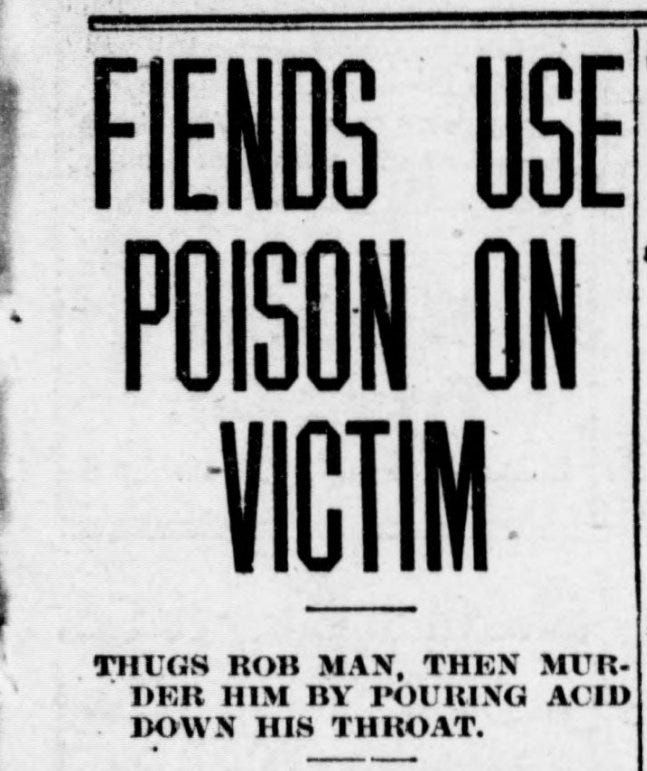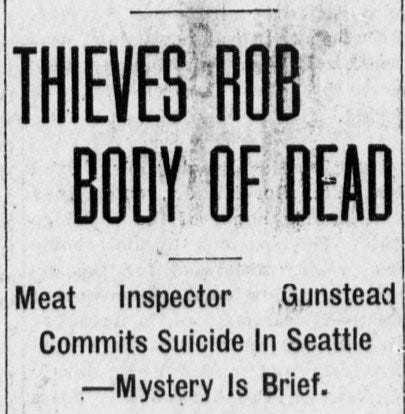Awful Murder in Seattle
"One of the most unusual and fiendish crimes ever committed"; PLUS problematic pilgrim, Pablo podcast, publishing programme
“Seized from behind by two or more men, garroted, dragged to an alleyway, robbed, and then deliberately killed by having carbolic acid poured down his throat as he lay on the ground unconscious, was the fate that befell Charles A Gunstead.”
This was the grisly story that Seattle, Washington, woke to on the morning of 5 February 1910. Gunstead was found during the freezing early hours in a downtown alley near the waterfront. The well-built young man was sprawled lifeless on the cobbles, with his muddied clothes pulled up and twisted around his neck. His wallet had been emptied of money and shoved back into his pocket. Most shockingly, he had horrific burns around his mouth.
The story was fired across the United Press wires and landed on newspaper front pages across the US West Coast. One headline announced: “CARBOLIC ACID POURED DOWN MAN’S THROAT; Awful Murder in Seattle – Quarrel, Robbed, and Then Killed.” Other newspapers led with “FIENDS USE POISON ON VICTIM” and “THESE THUGS ARE FIENDISH.” All agreed that it was a singularly horrific crime. This is the Tacoma Times:
“The murder of Gunstead is one of the most unusual and fiendish crimes that has ever been committed in Seattle. There is not a mark on the man's body save the acid burns around his mouth, and he is a man of such powerful build that it is certain that he would put up a hard fight before being overpowered.”
It was a baffling mystery – a howdunnit as much as a whodunnit – but the presence of a handful of clues meant it would soon be solved.
Gunstead’s body was found on Post Avenue near Yesler Way by a passer-by named Martin Mevsick, described in newspapers as “a Greek”. Mesvick alerted RC Becker, a night watchman at the adjacent Seattle Electric company plant. Becker said he had heard a scuffle outside his door but had not investigated it. Certainly, it seemed that Gunstead had been robbed by a group of assailants. The Tacoma Times continued:
“When the body was picked up by Deputy Coroner Hill, the man’s coat and vest had been pulled up around his neck, while the underside of his clothes showed beyond any possible doubt that he had been dragged along the muddy street for at least a block. Gunstead’s pocketbook had been cleaned of all of the money it contained and had then been stuck back in his trousers pocket.”
Gunstead was identified as being from St Paul, the state capital of Minnesota. Several letters were found on his person. Most were applications for employment at various firms in Seattle. Another was from the Frye-Bruhn company, a wholesale butcher, where Gunstead had been working as a meat inspector:
“It was a notice of discharge and had been accompanied by a check for $18.”
This last clue – evidence of recent unemployment and a missing payment – propelled the coroner’s inquest towards a swift conclusion. Carbolic acid seemed an unlikely murder weapon. Although there was evidence Gunstead had been robbed and manhandled, there was no evidence that he had been subdued to the extent required for the assailants to pour acid down his throat. It seemed more likely that Gunstead might have ingested the acid himself.
The Deputy Coroner had initially assumed that if Gunstead had been robbed, he could not have committed suicide. But this was not necessarily true. By the time the evening newspapers hit the stands, the mystery was over.
“THIEVES ROB BODY OF DEAD,” announced one headline. “Meat Inspector Gunstead Commits Suicide In Seattle — Mystery Is Brief.”
Several newspapers published the following Press Association report:
“An inquest over the body of Charles A Gunstead, a meat inspector found dead at midnight, revealed suicide by carbolic acid. He had fallen in the roadway and rolled about in agony, causing bruising and disarrangement of his clothing, which resulted in the report he had been garroted. He had been discharged by his employer yesterday. It is supposed the loss of his position impelled him to commit suicide. Thieves had robbed the body of all articles of value before he was found.”
A week later, on 12 February 1910, the Seattle police received a telegram from Chief of Police Horriston of Minneapolis. Horriston asked them to find and notify one Charles A Gunstead that his wife had died in Minnesota after an illness. That would, of course, not be possible.
“Gunstead was already dead by suicide. The finding of his body, which had been dragged into a dark spot and robbed, gave rise to a sensational story of murder. Gunstead had been despondent because [he was] unable to find steady employment, and the sickness of his wife is now given as an additional reason for suicide.”
Tragically, Gunstead had taken his own life before his body was dragged into an alley and robbed. So what began as a bizarre murder mystery was revealed to be a sad tale of a man grappling with the harsh realities of life during a tumultuous era of hardship.◆
Recommended
Pilgrim’s Wilderness by Tom Kizzia (2013)
A hat-tip is due here to Will Storr, who recommended this book on Andrew Hankinson’s Logroll podcast. I completely missed it when it was released more than a decade ago, but I’m glad to have rectified that. It’s the gripping true story of Papa Pilgrim, AKA Bobby Hale, a wild-bearded wanderer who turns up in the remote Alaskan town of McCarthy in 2002 with his wife and 15 children. At first glance, the Pilgrims appear to be a simple, old-timey family looking to live a pious and peaceful life in the wilderness. But Papa soon becomes embroiled in disputes between the National Park Service and the community, and dark secrets from his past and sinister truths about his family begin to emerge. Tom Kizzia was a reporter for the Anchorage Daily News and a sometime neighbour of the Pilgrims. He’s written a meticulous page-turner, covering a story that plunges to nightmarish depths but ultimately, I think, is one of remarkable survival. It’s a wild story, too, that threads in the Kennedy assassination, Charles Manson, the Maharishi Mahesh Yogi, and Jack Nicholson within the space of a few pages. A compelling read.
You can get Pilgrim’s Wilderness here, and find it on our Amazon bookshelf.*
The Atavist is one of my favourite publishers of longform narrative non-fiction. Its most recent story is Mayday by William Ralston, about the 2023 search for four missing plane crash children in the Amazon. Other recent highlights include The Truth Is Out There by Katya Cengel, about the disappearance of a Bigfoot hunter, and Who Killed The Fudge King? by Tom Donaghy, who solves a murder mystery during his summer holiday.
Varnamtown is a new podcast from Josh Davis and his colleagues at Epic with the actual Kyle MacLachlan from Twin Peaks. It’s about a small town in North Carolina that, in the 1980s, did a deal with Pablo Escobar to allow him to use it as a hub to import vast quantities of cocaine…
Publishing schedule
Singular Discoveries is currently published once a month. The number one piece of advice I’m given regarding this newsletter is “publish more often”. But there’s so much stuff out there and email inboxes are so busy that I’m not sure I want to do that. What do you think of the current monthly schedule?
One idea is to maintain the main monthly newsletter and add a bonus “Paul’s Notebook” newsletter that delves into behind-the-scenes musings, unpublished work, and writing tips. So you’d get two newsletters a month. Let me know what you think.
More next time. Please share and subscribe. Thanks for reading. ◆
Main sources: Tacoma Times, Spokane Press, Coos Bay Times, Santa Cruz Evening News, all 05/02/1910, and San Francisco Call, 13/02/1910.
If you have been affected by issues mentioned in this post, you can contact Samaritans in the UK or 988 Lifeline in the US.
*This publication features Amazon affiliate links. If you use them, I may receive a few pennies to help fund the newsletter. See our Amazon bookshelf here.







